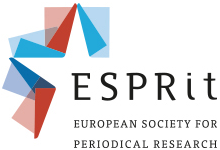ESPRit online seminar 17 June 2022
The third ESPRit online seminar series takes as its general theme ‘sources beyond the periodical text’. It launches on 8 April 2022 with an opening lecture by Filippos Tsiboglou, Director General of the National Library of Greece, followed by two research presentations (by Zsuzsa Török and Levente T. Szabó) on 13 May. The third session, to be held on 17 June 2022 at 3 PM CET, featured the following contributions:
Nora Ramtke (Ruhr-Universität Bochum), ‘August Lewalds Europa (1835-1844) and its Supplements: Archiving the Abundance’
The most basic question of what belongs to a periodical when it comes to archiving practices is not always an easy one. Whether periodical scholars work with digitised periodicals or with archived material, we know that we don’t examine them in the state in which they were published originally but bound in a more or less book-like form and then again converted to digital copies. August Lewald’s Europa, a popular magazine published in the 1830s and 1840s, came out with a whole bunch of supplements, fashion plates, lithographs, steel engravings, and music sheets. I will discuss this periodical as a fascinating example in terms of material diversity that reveals traces not only of various archiving practices but of notions of bookishness and periodical formats.
Hannah Connell (King’s College London and British Library), ‘Uncovering the relationships between periodicals through editorial correspondence: Networks of Russian-language emigre periodicals in interwar Paris’
Sovremennye zapiski (Contemporary Notes) is the preeminent Russian-language literary and socio-political journal published between 1920 and 1940 in Paris. Smaller periodicals targeting specific communities appear and disappear with great regularity in the Russian-language publishing landscape of interwar Paris. Sovremennye zapiski’s editors kept a close eye on developing trends in interwar periodical publishing. Their editorial correspondence reveals more than simply the procedures behind a single journal. Significant aspects of SZ’s collaboration and competition with newspapers and magazines are visible through these editorial discussions. In addition, there is relatively little substantial editorial correspondence for other Russian-language émigré periodicals. It is possible, however, to recover certain aspects of the editorial procedures of other periodicals from the editorial archive of SZ. Understanding the relationships between these periodicals reveals how the place of this thick journal in émigré society changed over its publishing life.
